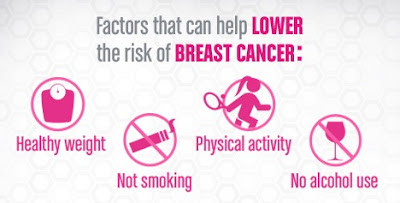 |
| Breast Cancer Causes |
Breast Cancer Causes
Gender
Gender is one of the biggest risk causes because breast cancer mostly occurs in women. While men also get the disease, it is about 100 times more common in women than in men.
Age
Age is another critical factor that causes breast cancer, even though breast cancer may occur at any age but the risk increases with age. Generally, women over 50 are more likely to get breast cancer than younger women. Most breast cancers (about 80%) develop in women over the age of 50. The average woman at age 30 years has one chance in 280 of developing breast cancer in the next 10 years. This chance increases to one in 70 for a woman aged 40 years, and to one in 40 at age 50 years. A 60-year-old woman has a one in 30 chance of developing breast cancer in the next 10 years.
Race
African-American women are more likely than Caucasian to get breast cancer before menopause but white women are slightly more likely to develop breast cancer than African American women in the U.S. and also African American women are more likely to die of breast cancer due to faster growing tumors in their race. Statistics show that Asian, Hispanic, and Native-American women have a lower risk of getting and dying from breast cancer. Why this is the case and cause, is unknown.
Benign Breast Disease
Certain benign (not cancer) breast problems can cause increased risk of breast cancer. Fibrocystic breast changes are very common. Fibrocystic disease temporary changes in the breasts that coincide with the menstrual cycle especially right before the menstrual period. Fibrocystic breasts are lumpy with some thickened tissue and are frequently associated with breast discomfort. This condition does not lead to breast cancer.
However, certain other types of benign breast changes, such as those diagnosed on biopsy as proliferative or hyperplastic, do predispose women to the later development of breast cancer. Moderate or severe hyperplasia alone may increase breast cancer risk by 1.5- to 4-fold; however, when associated with atypia, the risk may causes to be increased as much as 5-fold. If a woman also has a family history of breast cancer in first-degree relatives, her risk may be increased 11-fold.
Family History Of Breast Cancer
Breast cancer risk is higher among women whose close blood relatives have this disease. The relatives can be from either the mother's or father's side of the family. However, approximately 85% of women with breast cancer do NOT report a history of breast cancer within their families. The remaining 15%, about one-third appear to have a genetic abnormality. Nevertheless, having a mother, sister, or daughter with breast cancer about doubles a woman's risk. The risk can increased 4- to 5 times if the relative's cancer was found before menopause.
Alcohol Use
Drinking alcohol regularly -- more than a couple of drinks a day -- may be the cause and promote the cancer. By contrast, breast cancer risk is nearly doubled in women who have more than three drinks daily. Those who have 2 to 5 drinks daily have about 1½ times the risk of women who drink no alcohol. The American Cancer Society suggests limiting the amount you drink to one drink a day. There is a recognized relationship between the consumption of more than two drinks a day and an increased level of estrogen in the blood that could be the breast cancer causes.
Being Overweight
Being overweight is linked to a higher risk of breast cancer. Women whose diets are high in fat are more likely to get the disease. The link between diet and breast cancer causes are debated as studies of fat in the diet as it relates to breast cancer risk have often given conflicting results. Researchers suspect that if a woman lowers her daily calories from fat -- to less than 20%-30% -- her diet may help protect her from developing breast cancer. Nonetheless, exercise appears to be beneficial, no matter what a woman's body size.
 Learn What Breast Cancer is and How to Deal with It.
Learn What Breast Cancer is and How to Deal with It.
No comments:
Post a Comment